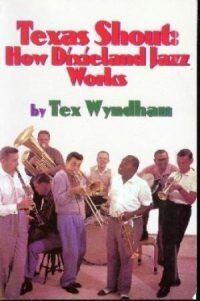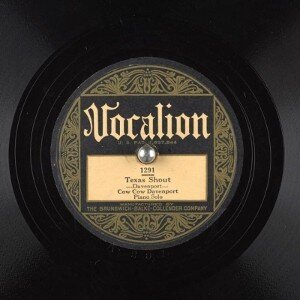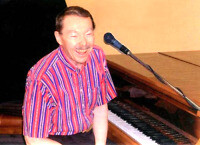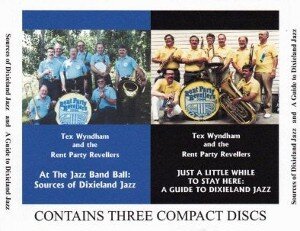Set forth below is the twenty-sixth “Texas Shout” column. It first appeared in the March 1992 issue of the West Coast Rag, (now Syncopated Times.) The following note was added when the column was reprinted in April 1999.
The article refers to a nightclub at which Dixieland was played on some Saturday nights, the gig having been moved up an hour because the audience went home before the last set. Since 1992, the band has been switched from Saturday night to Sunday afternoon. By that time, I had gone on to other things, but I feel certain that the change to a different day and earlier time was the result of the circumstances discussed below.
Further, since 1992, the Dixieland audience has come to be comprised almost entirely of folks aged 65 or over, people who are more reluctant to get up and go out of the house than they used to be. All of the newsletters I receive from Dixieland jazz societies — covering various regions of the country — have been lamenting dropoffs in attendance at their normal periodic presentations. A number of them can no longer make money on admissions, but are dependent for profitability on a few angels among the membership who supply subsidies for specific concerts.
The nearest Dixieland society to my home is no longer viable, attracting only about 50-60 people to its events. Even though it’s only about a forty-five minute drive from here, so my Red Lion Jazz Band can charge our local-area price, the club can’t afford seven pieces anymore. We played it five or six times in the good old days, but haven’t done so for several years now. I expect that, before long, I’ll hear of its collapse and a melding of its activities into those of two somewhat more distant clubs that themselves are hanging on by their fingernails.
In the mid-1980s, I had a chance to talk about the economics of the tavern/restaurant business with the manager of a room that regularly hired musical entertainment. What he told me made sense to me. I suppose that it is still true in its general aspects.
Moreover, the information told me a lot about why the Dixieland club scene, and indeed the broader Dixieland world, is the way it is. Thus, I thought you might find it interesting as well.
The information consisted of two rules of thumb. First, the margin on drinks is 50% and on food is 10%. Second, in order to sustain live entertainment, the room needs to be able to sell at the bar a total of three times whatever the entertainment costs.
Note that the gross sales requirement only applies to sales at the bar. The margin on food is too small to be worth bothering with in a typical club. (This situation may not be true if the establishment is primarily a restaurant; however, such venues are not as likely candidates to hire Dixieland bands as are taverns that also serve a light menu.)
Checking to see if the rule of thumb made sense, I postulated hiring live entertainment for, say, $500 for the evening. That means the club needs to sell $1,500 at the bar, on which it realizes a margin of $750. However, it has to pay the act $500, leaving a before-tax profit of $250, and an after-tax profit of about $160.
Now if the room would typically sell $500 at the bar anyway, it can get that same $160 by having no entertainment at all. (Again, food doesn’t enter into the equation, because even another $1,500 of food sales would only add about $100 after tax to the take.)
Perhaps someone out there will confirm whether these calculations are in the ballpark, but they seem plausible enough to me. Whatever the right figures are, a club owner probably isn’t going to go to all the hassle to hire live entertainment, set up extra tables, etc., unless he has reason to think that he will do significantly better financially than he will if he doesn’t hire live entertainment.
Let’s assume that these rules of thumb are generally accurate and see how they might apply to hiring a Dixieland band. Just to put things on the low side, we’ll postulate that we have a six-piece band (not the typical seven, or the eight that go with the two-trumpet sound), that the musicians get $50 apiece for the evening (pretty much a minimum), and that there is no additional charge for a leader’s fee.
In that case, it costs at least $300 to hire the band, so the audience needs to drink $900 worth to even begin to make the date worthwhile for the club. That $900 will be spread over the patronage for the evening.
How many customers can we handle? It’s pretty common for taverns to have less than 100 seats commanding an uninterrupted view of the bandstand. However, even at 100 seats, and a reasonable assumption on drink prices, our audience needs to drink about two drinks per person during the evening just to get things to the breakeven point.
Well, two drinks doesn’t seem all that much, you say. Besides, audience turnover during the evening hasn’t been taken into account. Normally I’d agree with you, but not with respect to the Dixieland market which, for reasons I’ve previously discussed in this column, currently is almost exclusively confined to senior citizens.
Older folks don’t drink as much as younger folks. Perhaps it’s because many of them are on fixed incomes, perhaps they are intrinsically more conservative in looking out for themselves, perhaps they pay more attention to the recent focus on drunken driving, or some combination thereof. (Maybe more of the really heavy drinkers kill themselves off before reaching senior citizen status.)
Also, older folks don’t stay out as late as younger folks, a fact which reduces turnover at Dixieland night clubs nearly to zero. (In fact, as this column was in process, I received a Dixieland jazz club newsletter saying that, in response to members’ expressed desires, meeting times have been moved up to 1:30-4:30 p.m. on Sunday afternoons!)
Recently I worked a 9:00 p.m.-1:00 a.m. Saturday night Dixieland gig that invariably opened to a packed house which dwindled down into a ghost town after midnight. Moving the starting time back to 8:00 p.m. didn’t really cure the problem of playing the last set to a pretty thin audience.
As it happened, the club was one that normally stayed open until 2:00 a.m. on Saturdays. When we weren’t playing, it usually presented music that appealed to a younger crowd.
The manager couldn’t help noting that, even though the place was packed when the Dixieland band began playing, his Dixieland Saturdays were always his financially least successful. Not only did the older Dixieland audience drink less per person, but the club lost two hours of business between midnight and 2:00 a.m., when a younger crowd would still be on hand spending money.
To return to our example, it’s really not that easy to get an older group to spend the required $900 on drinks in a typical small-to-moderate sized neighborhood tavern. And remember, every dollar spent — to hire an extra musician or an extra waitress, to pay for advertising, to tune the piano — requires an extra three dollars at the bar to get the club back to Square One.
The foregoing discussion, I believe, fairly represents the economics of today’s Dixieland band tavern scene. It explains a number of things about what confronts us when we get the urge to go out for an evening and hear some older-style jazz.
It explains, for example, why it’s so hard to find any. When I first became interested in the music, in the 1950s, just about every big city had a club where you could hear Dixieland played, at least on weekends, but usually nightly, often by full-time professionals. Now, even in our largest metropolitan areas, you can’t be sure of finding a Dixieland band at all, let alone one of sufficient quality to justify the time and expense of going to hear it.
There are two notable exceptions to that statement, however. In New Orleans, where Dixieland is a well-known part of the cultural heritage and a prime tourist attraction, you’ll find clubs which regularly feature Dixieland combos, and there are a number of full-time musicians making their living playing Dixieland. Similarly, in the Orlando area, where Walt Disney’s operations have established nostalgic entertainment as a key part of the atmosphere, Dixieland is sustained on a steady and visible level.
For the rest of the U.S., you can probably count on your fingers the number of full-time organized Dixieland combos. By that term I mean bands that do not play other styles of music than Dixieland and are made up of musicians who derive all of their income from playing Dixieland music, not significantly supplementing it with such things as teaching music, studio and dance work or part-time non-musical activities. The most prominent example thereof is probably Jim Cullum’s excellent septet in San Antonio. Is there another one of comparable stature?
Sadly but truly, Dixieland jazz doesn’t come anywhere near paying its way these days. In fact, this situation exists not only in the nightclub scene, but everywhere else in the field.
Dixieland festivals, for example, dot the landscape, particularly on the West Coast. Some of them are regarded as profitable, reporting significant earnings to further the cause of our music.
However, every festival I know of is critically dependent on the efforts of dozens, sometimes hundreds or thousands, of unpaid volunteers in order to function as it currently does. I feel sure that, if every such volunteer were paid the minimum wage for each hour spent in festival work, the festival scene would sink beneath a sea of red ink.
The same thing is true of recordings. The vast majority of recorded Dixieland released today is financed by the artists themselves (sometimes for vanity reasons), partly because independent production of such records is a weak competitor for investment money. In most cases, a person thinking of producing a Dixieland album could save himself a lot of time and effort, and easily do better financially, by putting his funds into a long-term high-quality bond.
Indeed, of the very few producers who’ve committed themselves to Dixieland in a major way during recent years, all the ones I know are lifelong fans motivated essentially by artistic reasons in their recording projects. Frequently, they plow all of whatever profits they do make into the production of additional recordings.
Well, thank Heaven for such people, and for the wonderful folks who act as volunteers at festivals. Without them, we would all be much the poorer, not only in terms of opportunities to hear our favorite music but of opportunities to meet some of the friendliest, most warm-hearted and generous human beings on the planet.
The fact that Dixieland jazz is not commercially viable also provides, to me, a simple logical answer to a question that I’ve frequently encountered, namely “Why aren’t more Black musicians playing Dixieland?” Given that (1) most Dixieland performers these days are hobbyists, (2) playing an instrument at a level required to execute Dixieland effectively calls for a very substantial investment of time in both practicing and in understanding the idiom, (3) the proportion of the white population involved in Dixieland today is minuscule and (4) anyone deciding to learn to play Dixieland will be doing so with full knowledge that he is unlikely to be compensated for putting in that time in an amount anywhere near what his time is worth — given all those things, is it surprising that so few Blacks elect to become Dixielanders?
To put it another way, in order to choose to play Dixieland anymore, a person will usually have achieved a sufficient level of affluence to be able to indulge a very time-consuming hobby. Proportionately, far fewer Blacks than whites have achieved such a level of affluence. If you calculate the number of whites who play Dixieland as a percentage of whites in the general population who live above the poverty level, and if you apply that same percentage to the number of Blacks in the population who live above the poverty level, how many Black Dixielanders would you expect to come up with?
I’ve often read that there are sociological reasons discouraging today’s Blacks from playing Dixieland — that the music carries a cachet of Uncle Tomism, that subtle social pressures prevent Blacks from entering what has now become a Dixieland environment that is all white, etc. I’m not a sociologist and would not attempt to speak to such points. I suppose, though, that there is some merit to those ideas.
However, I can’t help noticing that, at least in New Orleans where the scene is commercially viable, there are Black musicians (and some younger ones, too) playing Dixieland. Thus, when I see the question “Why aren’t more Blacks playing Dixieland?,” I mentally say to myself “I’ll bet that relatively few can afford to do so.”
Part 2
Back to the Texas Shout Index.

The full run of “Texas Shout” has been collected into a lavishly illustrated trade paperback entitled Texas Shout: How Dixieland Jazz Works. This book is available @ $20.00 plus $2.95 shipping from Tex Wyndham, On request, Tex will autograph the book and add a personalized note (be sure to tell him to whom the note should be addressed).
Tex Wyndham’s 3 CD Guide to Dixieland with music and commentary is available for $20 plus $2.95 shipping. The separate CD, A History of Ragtime: Tex Wyndham Live At Santa Rosa, is available for $13.00 plus $2.00 shipping. On request, Tex will autograph the inner sleeve and add a personalized note (be sure to tell him to whom the note should be addressed).
Send payment to Tex Wyndham, P.O. Box 831, Mendenhall, PA 19357, Phone (610) 388-6330.
Note: All links, pictures, videos or graphics accompanying the Shouts were added at the discretion of the Syncopated Times editorial staff. They did not accompany the original columns and do not necessarily reflect the opinion of Tex Wyndham.
From roughly 1970-2010, Tex Wyndham was: (1) one of the best-known revivalist Dixieland jazz musicians in the US, as cornetist, pianist and bandleader, (2) one of the best-known ragtime pianists in the US, and (3) one of the most respected critics in the US of Dixieland jazz, ragtime, and related music. He is the only person about whom all three of those statements can be made.



















